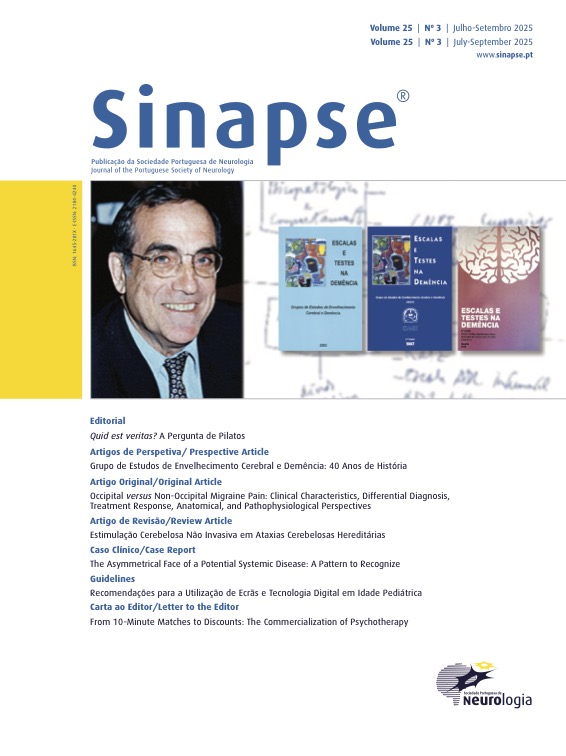Guidelines for Screen Time and Digital Technology Use in the Pediatric Age
DOI:
https://doi.org/10.46531/sinapse/GU/163/2025Keywords:
Adolescent, Child, Child Development, Computers, Digital Technology, Screen Time, Time FactorsAbstract
In view of the scientific evidence currently available on the negative impact of the inappropriate use of screens and digital technology on the health of children and adolescents, the members of the Portuguese Society of Neuropediatrics (SPNP) propose evidence-based recommendations adapted to the national reality and aimed at parents, educators and civil society. For each stage of neurodevelopment, screen time limits are indicated and guidelines are provided regarding content and contexts of use, promoting a healthier life in the digital world. These recommendations are also important to support the indications given in medical consultations for children and adolescents.Downloads
References
Reid Chassiakos Y, Radesky J, Christakis D, et al. AAP Council on Communications and Media. Children and Adolescents and digital media. Pediatrics 2016; 138(5):e20162593.
Madigan S, Browne D, Racine N, Mori C, Tough S. Association Between Screen Time and Children’s Performance on a Developmental Screening Test. JAMA Pediatr 2019;173(3):244–250. doi:10.1001/jamapediatrics.2018.5056.
Christakis, D. A. Interactive media use at younger than the age of 2 years: Time to rethink the American Academy of Pediatrics guideline? JAMA Pediatr 2019, 173(5), 399-400.
Ponti M. Screen time and preschool children: Promoting health and development in a digital world. Canadian Pediatric Society. Digital Health Task Force. Paediatrics & Child Health 2023, 28, 184–192.
Guidelines on physical activity, sedentary behaviour and sleep for children under 5 years of age. Geneva: World Health Organization; 2019. Licence: CC BY-NC-SA 3.0 IGO.
McDaniel BT, Radesky JS. Technoference: Parent Distraction with Technology and Associations with Child Behavior Problems. Child Dev. 2018 January ; 89(1): 100–109.
Twenge, J. M., & Campbell, W. K. Associations between screen time and lower psychological well-being among children and adolescents: Evidence from a population-based study. Preventive Medicine Reports 2018, 12, 271-283..
Tremblay, M. S., et al. Systematic review of sedentary behaviour and health indicators in school-aged children and youth. International Journal of Behavioral Nutrition and Physical Activity 2011, 8, 98.
Sheppard, A. L., & Wolffsohn, J. S. "Digital eye strain: prevalence, measurement and amelioration." BMJ Open Ophthalmology 2018, 3(1), e000146.
Bozzola E, Spina G, Agostiniani E et al. The use of social media in children and adolescents: scoping review on potential risks. Int J Environ Res Public Health 2022; 19, 9960.
Physical activity and exercise guidelines for all Australians; acessível em: https://www.health.gov.au/topics/physical-activity-and-exercise/physical-activity-and-exercise-guidelines-for-all-australians?utm_source=health.gov.au
Downloads
Published
How to Cite
Issue
Section
License
Copyright (c) 2024 Mafalda Sampaio, Tiago Proença dos Santos

This work is licensed under a Creative Commons Attribution-NonCommercial 4.0 International License.








